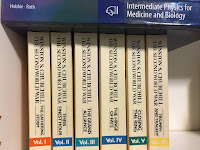When I teach, one of my goals is to help students analyze a mathematical equation to uncover the underlying physics. Equations are not merely expressions you plug numbers into to get other numbers; equations tell a story. Students often begin the semester knowing the required math and physics, but have difficulty connecting the two. One way students learn this connection is by taking limits of mathematical equations, so they can show that the equation behaves as it should when some key variable is large or small. If the equation is too complicated, taking the limit may be so difficult that the student gets lost in the algebra (see the February 20
blog entry about “the ugliest equation”). If the equation is too simple, taking the limit may be trivial. The best examples are of intermediate difficulty: students must do some work to take the limit, but their result provides physical insight.
One of my favorite examples is Problem 29 of Chapter 4 in the 4th edition of
Intermediate Physics for Medicine and Biology. I should be more specific: parts (b)-(d) of that problem are just the sort of practice the students need (part (a) of the problem is for masochists).
Problem 29 Consider an impervious plane at z = 0 containing a circular disk of radius a having a concentration C0. The concentration at large z goes to zero. Carslaw and Jaeger (1959) show that the steady-state solution to the diffusion equation is
(a) (optional) Verify that C(r, z) satisfies ∇
2C = 0. The calculation is quite involved, and you may wish to
use a computer algebra program such as Mathematica or Maple.
(b) Show that for z = 0, C = C0 if r is less than a.
(c) Show that for z = 0, dC/dz = 0 if r is greater than a.
(d) Integrate Jz over the disk (z = 0, r between 0 and a) and show that i = 4DaC0.
I’m amazed that the convoluted expression for the concentration,
C(r, z), containing an
inverse sine function with a complicated
argument does indeed obey
Laplace’s equation. I once proved that this is true, but have no intention of doing so again—it’s a mess. Before analyzing parts (b)-(d) of the problem, let’s examine the claim that “the concentration at large
z goes to zero.” Exactly how does it go to zero? Far from the disc (
z is much greater than
a) the concentration should fall off as the inverse distance (just as the electrical potential of a point charge falls off as 1/
r). When
z is large, the argument of the inverse sine function is small, and it can be approximated using the first term of its
Taylor series: sin
-1(
x) ~
x. In that case, the concentration becomes
2aC0/πz, falling off with the inverse distance as expected.
The behavior at small
z is more puzzling and the solution has the astonishing property that it changes its behavior at
r =
a. For
r less than
a the concentration is constant, but for
r greater than
a the derivative of the concentration is zero. How can such a relatively simple analytical expression display such a discontinuous behavior?
To answer that question, let’s analyze the equation for the concentration. The key step in our analysis is when we factor out (
r – a)
2 from the first square root in the denominator of the argument. This factor is always positive because the quantity is squared. But when removed from inside the square root, it becomes |
r – a|, with the absolute value needed to ensure that the expression remains positive. There are two cases:
r less than
a, when we replace |
r – a| by (
a – r); and
r greater than
a, when we replace |
r – a| by (
r – a). The rest is an exercise in Taylor series resulting from the limit as
z goes to zero. Use the expansion √(1 +
x2) = 1 +
x2/2 for the two square roots, simplify the denominator as much as possible, and then use the expansion 1/(1 -
x) = 1 +
x to find that for
r less than
a
and for
r greater than
a
For all the gory details see the solution manual, available free-of-charge to instructors using
IPMB in their class; email Russ Hobbie or me (roth@oakland.edu) for a copy.
Now we can do parts (b)-(d) of the homework problem. For part (b), when
r is less than
a set
z = 0 and use that sin
−1(1) = π/2 to find that
C(r,0) = C0, independent of
r. For part (c), when
r is greater than
a take the derivative of the inverse sine function with respect to
z, and then set
z = 0. Because the argument of the inverse sine is even in
z, at
z = 0 the derivative
dC/dz vanishes.
Part (d) is tricky. Using the same argument as above, we might expect that because the argument of the inverse sine is even for
r less than
a the derivative
dC/dz must be zero. But no! The derivative of sin
−1(
u(
x)) is 1/√(1−
u2)
du/dx. When we take the derivative of the expression for
C(r,z) for
r less than
a and then set
z = 0, we get not only zero in the numerator (because
du/dx = 0; the function is even) but also zero in the denominator (because √(1−
u2) = 0 in this case). The result is
dC/dz = −
2C0/π√(a2 − r2).
To find the total number of particles per unit time
i coming out of the disk, we need to integrate the particle current density
Jz over the plane
z = 0. The current density is
Jz = –
D dC/dz, where
D is the
diffusion constant. Because
dC/dz is zero for
r greater than
a, we need to integrate the current density over only the circular area
r less than
a. You can look this integral up and find that
i =
4C0Da.
There are other aspects of the solution that are not emphasized in this problem, but are equally interesting. For instance,
Jz goes to infinity at
r = a. In other words, the number of particles leaving the disk is largest at the edge of the disk. This result is analogous to the concentration of electrical current near the edge of a disk electrode, discussed in Problem 22 of Chapter 6 in
IPMB;
Jz changes abruptly from an extremely large value for
r just less than
a to zero for
r just greater than
a. Another interesting result is that the total number of particles leaving the disk per unit time is proportional to the disk radius, not the disk area as you might naively expect. This result also has an analogy in electrostatics: the capacitance of a disk electrode relative to a distant ground is proportional to the radius of the disk, not the radius squared, which surprised me when I first encountered it (see Section 6.19 in
IPMB).
In retrospect, maybe this problem is slightly too complicated to be the perfect example of taking the limits of a mathematical expression to gain insight into the physical behavior. But for those whose mathematical skills are up to the job, it provides an excellent case study.
Mathematical equations tell a physical story. You must practice extracting that story from the math.



























